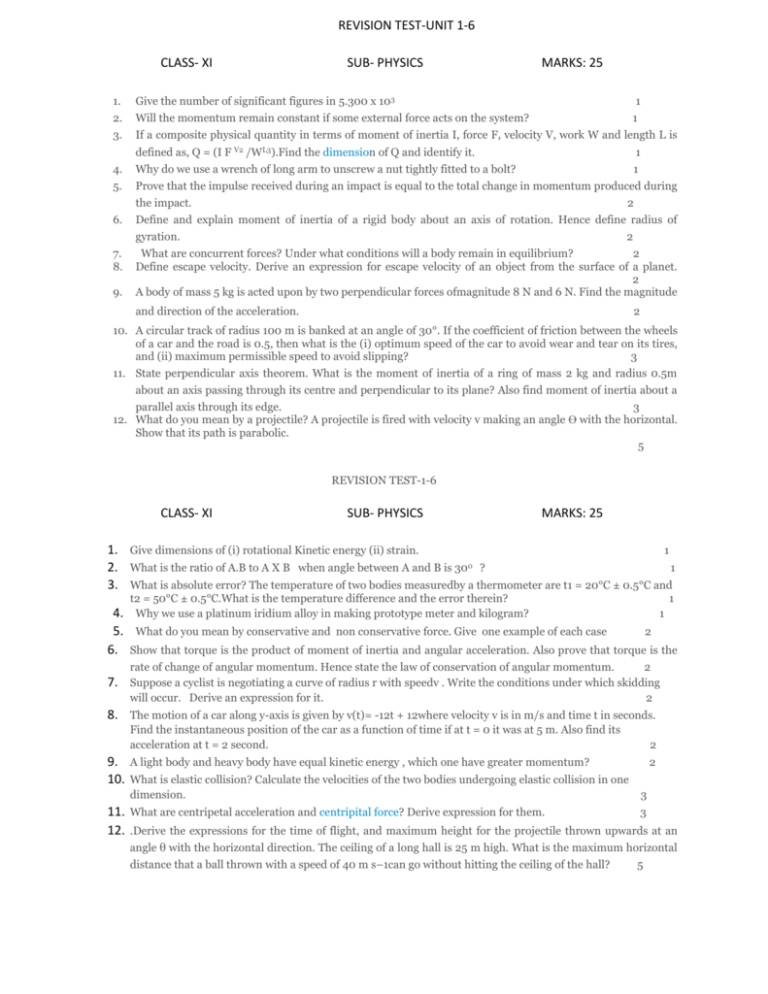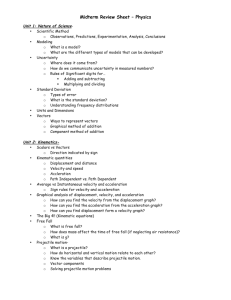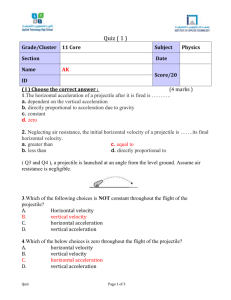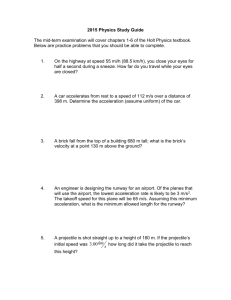REVISION test XI – 2015-16 physics
advertisement

REVISION TEST-UNIT 1-6 CLASS- XI SUB- PHYSICS MARKS: 25 1. Give the number of significant figures in 5.300 x 103 1 2. 3. Will the momentum remain constant if some external force acts on the system? 1 If a composite physical quantity in terms of moment of inertia I, force F, velocity V, work W and length L is 4. defined as, Q = (I F V2 /WL3).Find the dimension of Q and identify it. Why do we use a wrench of long arm to unscrew a nut tightly fitted to a bolt? 1 1 5. Prove that the impulse received during an impact is equal to the total change in momentum produced during the impact. 2 6. Define and explain moment of inertia of a rigid body about an axis of rotation. Hence define radius of gyration. 2 7. 8. What are concurrent forces? Under what conditions will a body remain in equilibrium? 2 Define escape velocity. Derive an expression for escape velocity of an object from the surface of a planet. 2 A body of mass 5 kg is acted upon by two perpendicular forces ofmagnitude 8 N and 6 N. Find the magnitude 9. and direction of the acceleration. 2 10. A circular track of radius 100 m is banked at an angle of 30°. If the coefficient of friction between the wheels of a car and the road is 0.5, then what is the (i) optimum speed of the car to avoid wear and tear on its tires, and (ii) maximum permissible speed to avoid slipping? 3 11. State perpendicular axis theorem. What is the moment of inertia of a ring of mass 2 kg and radius 0.5m about an axis passing through its centre and perpendicular to its plane? Also find moment of inertia about a parallel axis through its edge. 3 12. What do you mean by a projectile? A projectile is fired with velocity v making an angle Ө with the horizontal. Show that its path is parabolic. 5 REVISION TEST-1-6 CLASS- XI SUB- PHYSICS MARKS: 25 1. Give dimensions of (i) rotational Kinetic energy (ii) strain. 1 2. What is the ratio of A.B to A X B when angle between A and B is 300 ? 1 3. What is absolute error? The temperature of two bodies measuredby a thermometer are t1 = 20°C ± 0.5°C and t2 = 50°C ± 0.5°C.What is the temperature difference and the error therein? 1 4. Why we use a platinum iridium alloy in making prototype meter and kilogram? 1 5. What do you mean by conservative and non conservative force. Give one example of each case 2 6. Show that torque is the product of moment of inertia and angular acceleration. Also prove that torque is the rate of change of angular momentum. Hence state the law of conservation of angular momentum. 2 7. Suppose a cyclist is negotiating a curve of radius r with speedv . Write the conditions under which skidding will occur. Derive an expression for it. 2 8. The motion of a car along y-axis is given by v(t)= -12t + 12where velocity v is in m/s and time t in seconds. Find the instantaneous position of the car as a function of time if at t = 0 it was at 5 m. Also find its acceleration at t = 2 second. 2 9. A light body and heavy body have equal kinetic energy , which one have greater momentum? 10. What is elastic collision? Calculate the velocities of the two bodies undergoing elastic collision in one dimension. 2 3 11. What are centripetal acceleration and centripital force? Derive expression for them. 3 12. .Derive the expressions for the time of flight, and maximum height for the projectile thrown upwards at an angle θ with the horizontal direction. The ceiling of a long hall is 25 m high. What is the maximum horizontal distance that a ball thrown with a speed of 40 m s–1can go without hitting the ceiling of the hall? 5 REVISION TEST-1-6 CLASS- XI SUB- PHYSICS MARKS: 25 1. Calculate the moment of inertia of a uniform disc of mass 300 g and radius 15 cm, about its diameter. 1 2. A physical quantity P is related to four observables a,b,c and d as follows: P = a²b³ / c4 √d. The percentage errors in a,b,c and d are 2%, 4% ,3 % and 2% respectively. What is the 3. percentage error in the quantity P? 1 Draw the Position – Time graph for following cases when( i) Object is moving with positive acceleration 4. ( ii) An object is under free fall State and Prove Work- Energy Theorem for variable force case. 5. 6. Derive the necessary relation for orbital velocity of a satellite and prove that T2 α R3 using it. 2 (a) Three bodies of identical radii a ring a solid sphere and a solid cylinder roll down the same inclined 1 1 plane without slipping. They start from rest. Which of the bodies reaches the ground with maximum velocity ? (b) State the Parallel Axes theorem of moment of inertia. 3 7. 8. 9. Two masses 8 kg and 12 kg are connected at the two ends of an inextensible string that passes over a frictionless pulley. Find the acceleration of the masses and tension in the string when masses are released. 3 What do you mean by acceleration due to gravity? Derive the necessary relation for variation of g with depth. 3 Derive the equation S = ut + ½ at2 using graphical method. (b) A ball is thrown vertically upward with a velocity 20 m/s from the top of a multistory building. The height of the point from where the ball is thrown is 25 m from the ground, i) How high the ball rise? ii) With what velocity strike the ground ? 5 10. (a) A projectile is fired in air making an angle θ with horizontal. Show that (i) Its path is parabolic nature. (ii) tan θ = 4H / R where maximum height attained and R is the range of projectile.(b) An aircraft executes a horizontal loop of radius 1.00 km with a steady speed of 900 km/h. Compare its centripetal acceleration with the acceleration due to gravity. 5 REVISION TEST-UNITS 1-6 CLASS- XI 1. 2. 3. 4. 5. 6. 7. 8. 9. SUB- PHYSICS MARKS: 25 State Parallel and Perpendicular axes theorem. 2 Derive an expression for orbital velocity of an orbiting satellite. 2 Discuss elastic collision between two bodies in one dimension and obtain the expression for their velocities after collision. 2 Explain with the help of a diagram the motion of a car on a rough banked circular track and hence find a relation for the limiting velocity with which the car should turn without slipping. 3 Show that work done in increasing the speed of a body is equal to the change in Kinetic Energy produced. Derive a relation between rotational Kinetic Energy of a rigid body and its moment of inertia? 3 What is meant by projectile motion? Show the projectile fired making an angle with the horizontal is a parabola. Write the formula for a) time of light b) maximum height attained & c) horizontal range 3 Explain parallelogram law of vector addition. Two forces F1 and F2 acting at an angle Ө on a body simultaneously have a resultant F. show that Ө=cos-1(F2-F12-F22/2F1F2) 5 Derive the relation between linear and angular velocity. 2 Show that the total mechanical energy of a body falling freely under gravity is conserved 3 REVISION TEST-UNIT 1-6 CLASS- XI SUB- PHYSICS MARKS: 25 1. Define escape velocity. Derive an expression for escape velocity of an object from the surface of a planet. 3 2. What do you mean by a projectile? A projectile is fired with velocity v making an angle Ө with the horizontal. Show that its path is parabolic. 2 3. Define and explain moment of inertia of a rigid body about an axis of rotation. Hence define radius of gyration. 2 4. Is the acceleration due to gravity varying? Deduce an expression for the acceleration due to gravity at a height from the surface of earth. 3 5. Derive an expression for the potential energy of a spring. 3 6. What is Newton’s second law of motion? Give one example based on it. Derive the first and third law from the second law of motion. 3 7. Derive an expression for centripetal acceleration in case of uniform circular motion of an object. 5 8. i) State Parallelogram law of vector addition. ii) State triangle law of vector addition iii) Find analytically the magnitude and direction of resultant vector. 5 REVISION TEST-UNIT 1-6 CLASS- XI SUB- PHYSICS MARKS: 25 1. 2. 3. 4. 5. Prove that Vectors ¯A=ˆi+ˆ2j+ˆ3k and ¯B=2ˆi-ˆj are perpendicular to each other. 2 Show that the vectors ¯A=ˆi-5j and ¯B=ˆ2i-ˆ10j are parallel to each other. 2 State the polygon law of Vector addition. 1 Distinguish gravitational potential energy & gravitational potential. 2 State the laws of limiting friction. 6. If A =2i +3 j+ k and B =3i +2 j +4k , then find the value of : ( A +B)x( A - B ). 2 7. A police van moving on a highway with a speed of 30 km/hr. fires a bullet at a thief’s car speeding away in the same direction with a speed of 192 km/hr. If the muzzle speed of the bullet is 150m/sec. with what speed does the bullet hit the thief’s car? 3 8. A ballet dancer can increase her angular velocity by folding her arms and bringing the stretched leg close to the other leg. Explain why? 3 9. Define collision. Explain elastic, inelastic and perfectly inelastic collision. Show that when very heavy body colloids with a lighter body kept at rest then after collision heavy body continues to move with the same velocity while lighter body moves with the velocity twice to that of heavy body. Assume thecollision to be elastics. 5 10. Show that for two complementary angles of projection of a projectile thrown with the same velocity, the horizontal ranges are equal.(b) For what angles of projection of a projectile is the range maximum?(c) For what angle of projection of a projectile, are the horizontal range and maximum height attained by the projectile equal. 5 CLASS- XI 1. 2. 3. 4. 5. 6. 7. 8. 9. REVISION TEST-UNIT 1-6 SUB- PHYSICS MARKS: 25 If the % errorin the measurement of the radius R of a sphere is 0.2%, then calculate the % error in its volume. 2 Plot the velocity- time graph for a uniform motion. What does the area under the graphs indicate? 2 Two straight lines drawn on the same displacement time graph make angle30 º & 60 º with time axis respectively which line represents greater velocity? What is the ratio of the two velocities? 2 Define vector product of two vectors? Give one example. 2 A cricket ball is thrown at a speed of 28 m/sec in a direction 30˚ above the horizontal. Calculate (a) the maximum height, (b) the time taken by the ball to return to the same level and (c) the distance from the thrower to the point where the ball returns to the same level. 3 Define escape velocity. Derive an expression for escape velocity of an object from the surface of a planet. 3 Two balls are thrown simultaneously, A vertically upwards with a speed of 20 m/s from the ground and B vertically downwards from a height of 40 m/s with the same speed and along the same line of action. At what points do the balls collide? (g = 9.8 m/s2) 3 Is the acceleration due to gravity varying? Deduce an expression for the acceleration due to gravity at a height from the surface of earth. 3 A projectile is fired in air making an angle θ with horizontal. Show that (i) Its path is parabolic nature. (ii) tan θ = 4H / R where maximum height attained and R is the range of projectile. 5








